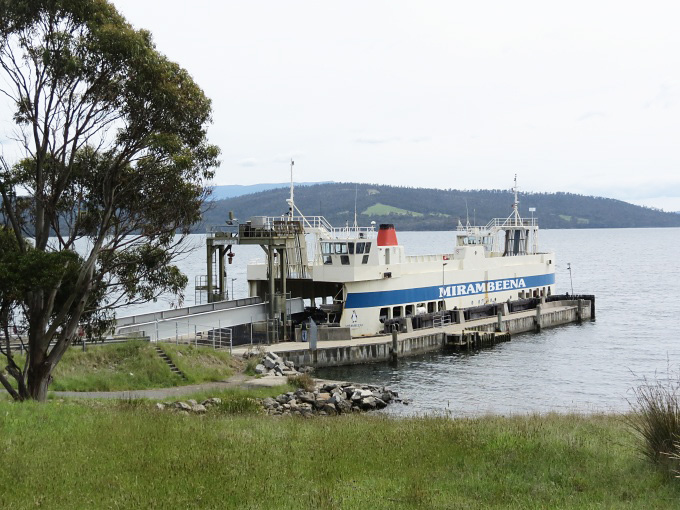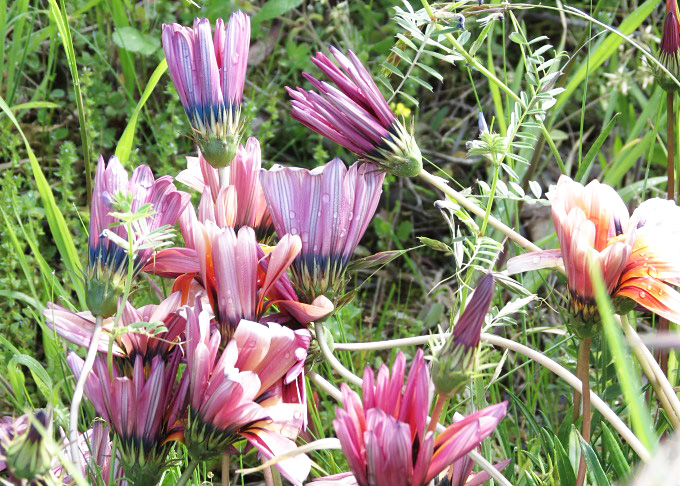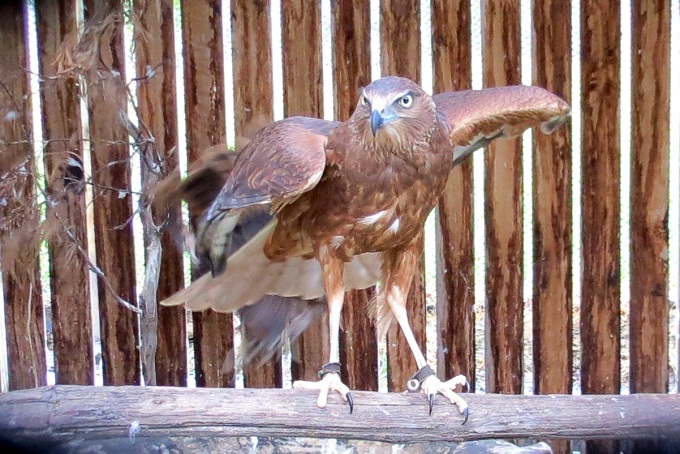Tasmanian Wine Tasting
/ Tasmania is known as the Apple Isle, so it was a surprise to learn that they're also a grape-growing island and a producer of cool climate wines. With mild, cool summers and long autumn days, the climate here is near perfect for grape-growing, it appears, and the local Pinot Noirs have gained an excellent international reputation in the red category. Chardonnays and Sauvignon Blancs excel in the whites. They also produce some sparkling wines. I really like bubbles.
We'd had dinner last weekend at the home of newly found local friends, Marcia and John. They'd treated us to some very lovely Tasmanian wines during the course of the evening including a Bay of Fires Tasmanian Cuvée Pinot Noir Chardonnay Brut (bubbles) and a Home Hill Pinot Noir Estate 2010. Both were excellent. So when they invited us for a day of wine-tasting along Tasmania's Southern Wine Route, how could we refuse? This is one of our serendipitous 90-day rule events. May we add right off the bat, that we're not wine connoisseurs by any means, but we do like drinking wine and we know what we like and what we don't.
Tasmania is known as the Apple Isle, so it was a surprise to learn that they're also a grape-growing island and a producer of cool climate wines. With mild, cool summers and long autumn days, the climate here is near perfect for grape-growing, it appears, and the local Pinot Noirs have gained an excellent international reputation in the red category. Chardonnays and Sauvignon Blancs excel in the whites. They also produce some sparkling wines. I really like bubbles.
We'd had dinner last weekend at the home of newly found local friends, Marcia and John. They'd treated us to some very lovely Tasmanian wines during the course of the evening including a Bay of Fires Tasmanian Cuvée Pinot Noir Chardonnay Brut (bubbles) and a Home Hill Pinot Noir Estate 2010. Both were excellent. So when they invited us for a day of wine-tasting along Tasmania's Southern Wine Route, how could we refuse? This is one of our serendipitous 90-day rule events. May we add right off the bat, that we're not wine connoisseurs by any means, but we do like drinking wine and we know what we like and what we don't.
 First, a little history, because you know how I am. I had to know more about Tasmania's winemaking before I went on the tour. Tasmania, believe it or not, was one of the earliest regions in Australia to be planted with grape vines. Tasmania's first vineyard was planted at New Town near Hobart in 1823 and in 1848, the vineyard's white wine won an award at the Paris Exhibition. It was the cuttings from this vineyard that were supplied for the first vineyards in Victoria and South Australia. And as the wine route guide pointed out “Tasmania can legitimately claim to be the oldest producing wine region in the country!”
First, a little history, because you know how I am. I had to know more about Tasmania's winemaking before I went on the tour. Tasmania, believe it or not, was one of the earliest regions in Australia to be planted with grape vines. Tasmania's first vineyard was planted at New Town near Hobart in 1823 and in 1848, the vineyard's white wine won an award at the Paris Exhibition. It was the cuttings from this vineyard that were supplied for the first vineyards in Victoria and South Australia. And as the wine route guide pointed out “Tasmania can legitimately claim to be the oldest producing wine region in the country!”
Cool climate wines require a late autumn harvest, usually in April to late May, equivalent to a northern hemisphere October-November timeframe. For once, global warming has a beneficial effect, allowing the grapes in some areas here to mature sooner and thus be harvested earlier. With somewhere around 250 individual vineyards on the island, there's lots to choose from. There are four distinct wine routes on the island and we visited three in the Hobart Area, all part of the Southern Wine Route. The Derwent Valley, the Huon Valley and the Coal River Valley regions have several vineyards and Marcia chose three to visit. They have limited open hours (Noon-5pm) and it's a slow, methodical process for all this tasting. We wanted to make sure we got it right.
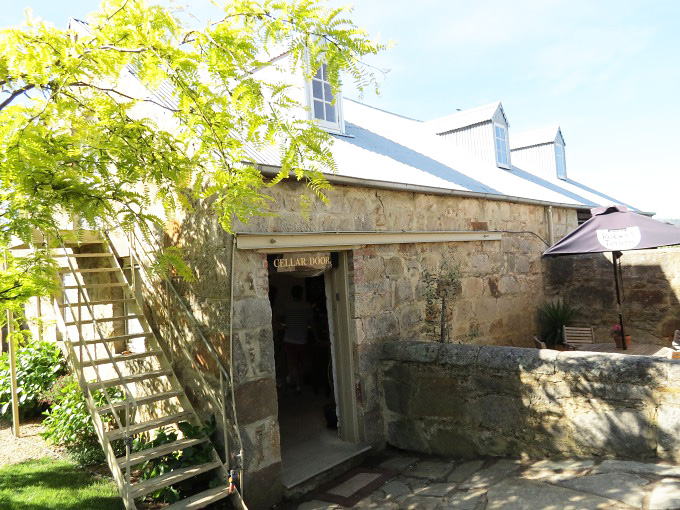 Our first stop was Nandroya Vineyards in Margate, not far from home. We called at the cellar door, the tasting and sales center for each vineyard. This vineyard is small and compact with astounding views of the D'Entrecasteaux Channel in the distance. Their production is limited and wines are purchased at the vineyard only. Marcia was very familiar with the wines and the owner, John, and so a lively conversation ensued. It seems John was having problems with the local possums and wallabies which had a particular liking for his grape vines and had defoliated several of the plants. Wombats were also an issue … issues we never even considered when we think about vineyards.
Our first stop was Nandroya Vineyards in Margate, not far from home. We called at the cellar door, the tasting and sales center for each vineyard. This vineyard is small and compact with astounding views of the D'Entrecasteaux Channel in the distance. Their production is limited and wines are purchased at the vineyard only. Marcia was very familiar with the wines and the owner, John, and so a lively conversation ensued. It seems John was having problems with the local possums and wallabies which had a particular liking for his grape vines and had defoliated several of the plants. Wombats were also an issue … issues we never even considered when we think about vineyards.
We tasted Pinot Noirs and an absolutely wonderful Sauvignon Blanc. The pace was easy-going. It was a gorgeous, warm sunny spring day. No rushing here. Tastings at Nandroya are free although several area vineyards now charge a fee.
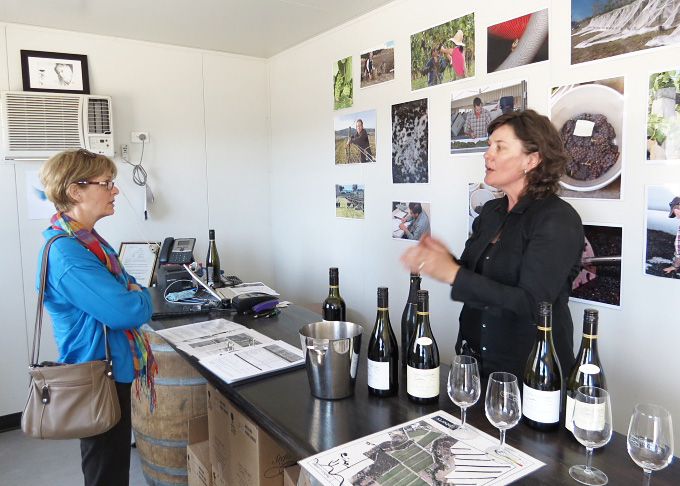 The next stop was Stefano Lubiana Wines in the Derwent Valley. Winemaking has a history in this family. For five generations, they've been making wines from Tuscany to Tasmania. Monique, Stefano's wife, was our hostess at the cellar door. There were several wines to try here, beginning with a sparkling wine, an NV Brut Reserve and I could have stopped right there. I'm into bubbles.
The next stop was Stefano Lubiana Wines in the Derwent Valley. Winemaking has a history in this family. For five generations, they've been making wines from Tuscany to Tasmania. Monique, Stefano's wife, was our hostess at the cellar door. There were several wines to try here, beginning with a sparkling wine, an NV Brut Reserve and I could have stopped right there. I'm into bubbles.
John doesn't drink at all (convenient when you need a designated driver) and David tried the bubbles then disappeared outside to chat with John about boats. That left Marcia and me to do all the work. We did a good job, working our way through about about a dozen different wines before Marcia decided to buy a bottle of the original bubbly. Tastings were free here, too.
 We picnicked on cheese, fruit and veggies before moving on to Pooley's Vineyard in the Coal River Valley. Pooley's is the 2012 Tasmanian Vineyard of the Year and has just racked up some big top gold awards at the recent Royal Melbourne Wine Show. The vineyard and cellar door are located on a beautiful historic property with a sandstone mansion as its centerpiece. Truth be told, I was more taken with my surroundings than the wine. We paid $5 each for the privilege of tasting about 12 more different wines. I think by the time we tasted the last one, it was hard to discern exactly what we were tasting and what we had tasted. We were feeling mighty mellow though.
We picnicked on cheese, fruit and veggies before moving on to Pooley's Vineyard in the Coal River Valley. Pooley's is the 2012 Tasmanian Vineyard of the Year and has just racked up some big top gold awards at the recent Royal Melbourne Wine Show. The vineyard and cellar door are located on a beautiful historic property with a sandstone mansion as its centerpiece. Truth be told, I was more taken with my surroundings than the wine. We paid $5 each for the privilege of tasting about 12 more different wines. I think by the time we tasted the last one, it was hard to discern exactly what we were tasting and what we had tasted. We were feeling mighty mellow though.
For folks who have admittedly purchased box wines in copious quantities before leaving on a passage, we found the wine prices to be quite high...anywhere from $25-$80/bottle and up.
I love the wine tasting jargon. I understand bouquet, nose, finish, oaky, savory, fruity, berry. Those are concrete, tangible, distinguishable descriptions and terms to me. But the marketing department works overtime I think when it comes to descriptions like “unusual seaweed-like note”, “poached fruit finish”, “perfumed hint of Ethiopian espresso and chocolate”, “mouth filling and chewy”. (Was there sediment left in the bottle?) Did you ever watch Kevin Kline and Meg Ryan in the movie French Kiss? Kevin is an aspiring French winemaker with an incredible sense of taste and smell. I thinking that's what I'm lacking. That and the fact I'm not a connoisseur. If I was, I could be more pretentious and I'd be able to create credible BS like this, too. Come to think of it, I used to be a marketer...I could do this; I really could.



